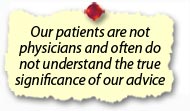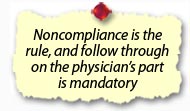|
|
|
Jarrod Shapiro, DPM
Practice Perfect Editor
Assistant Professor,
Dept. of Podiatric Medicine,
Surgery & Biomechanics
College of Podiatric Medicine
Western University of
Health Sciences,
St. Pomona, CA |
I like this phrase: Follow through.
Say it a couple of times. Follow through. Follow through.
Try changing where you place the accent. Is it "follow THROUGH" (used as a verb) or "FOLLOW through" (used as a noun)? This is an interesting phrase, because these two simple words confer so much meaning. And the lack of either of these leads potentially to failed patient care.
 When you institute treatment for your patients, do they do what you say? When you institute treatment for your patients, do they do what you say?
"Of course, they do," you say. And yet...I can hear the doubt creeping in. How do you know for sure?
Do you have FOLLOW through or do you fail to follow THROUGH?

Let me provide an example from my own practice. Ten days ago as of writing this editorial I performed surgery on a lady with a painful bunion and hammertoes. I did a Lapidus bunionectomy and arthroplasties of digits 2 and 3 with K wire fixation. On postop day 3, everything was going well, except the patient had failed to fill her pain prescription. "Luckily" for me – if you can call it that – she had a mild diabetic peripheral neuropathy and her pain response was somewhat blunted.
On the second postop visit (day 10), she came in with a dirty cast, worn away on the distal plantar surface. Clearly she was walking on her surgical foot, despite my prior admonitions to remain nonweightbearing.
On the second postop visit (day 10), she came in with a dirty cast, worn away on the distal plantar surface. Clearly she was walking on her surgical foot, despite my prior admonitions to remain nonweightbearing.
My failure with this patient was, among other things, a lack of follow through on education as well as preoperative prep work. As a general habit, I prescribe the postoperative medications for my patients before their surgery (unless I have reason to doubt the patient) to eliminate their need to pick up the meds immediately after surgery. In the preop holding area, I'll verify my patients have their meds waiting at home – AKA appropriate follow through.
Of course, with my patient example above, I broke my rule and sent the patient home after surgery with a script for her pain medications. I eliminated my ability to prophylactically follow through with the above result.
Additionally, I failed to follow through with my patient after instructing her to remain nonweightbearing. If I had made it clear how important her postoperative nonweightbearing was and then followed up on that, she may have been less likely to walk all over her Lapidus. Luckily for me, I didn't trust this patient to begin with, so had used a locking plate which afforded a small insurance policy against the walking. The patient is doing well with no major complications... yet.

My example demonstrates some of the pitfalls when we make assumptions. We often fail to recall that our patients are not physicians and often do not understand the true significance of our advice. It then behooves us to follow through on our patient education to prevent complications and improve outcomes.
 "But my patient's listen to me and follow my advice," the young practitioner argues. Oh, how experience is a harsh teacher! Of course, anyone who sees their own patients knows just how common noncompliance is. Armstrong and colleagues demonstrated this well in a prospective longitudinal study in which patients with plantar ulcers wore a pedometer on their hip along with a hidden one in their removable cast walker for seven days.1 The researchers found that only 28% of patients performed their home walking activities with the boot on, while the highest utilizers wore their boot only 60% of the time. What does this tell us? Noncompliance is the rule, and follow through on the physician's part is mandatory. This is why the total contact cast is so successful. It is not because it redistributes pressure but rather it forces compliance, removing the patient – and in fact the doctor – from the situation. "But my patient's listen to me and follow my advice," the young practitioner argues. Oh, how experience is a harsh teacher! Of course, anyone who sees their own patients knows just how common noncompliance is. Armstrong and colleagues demonstrated this well in a prospective longitudinal study in which patients with plantar ulcers wore a pedometer on their hip along with a hidden one in their removable cast walker for seven days.1 The researchers found that only 28% of patients performed their home walking activities with the boot on, while the highest utilizers wore their boot only 60% of the time. What does this tell us? Noncompliance is the rule, and follow through on the physician's part is mandatory. This is why the total contact cast is so successful. It is not because it redistributes pressure but rather it forces compliance, removing the patient – and in fact the doctor – from the situation.
There's another aspect of follow through that is very important for physicians: knowing the success rates of our treatment. When you place that plantar fasciitis patient in orthotics, do you follow up on them over a long enough time to know if their pain recurred? How about the triple arthrodesis you performed? Do you know if they remain pain free for ten or more years? How about one year? After they "recover" and disappear from your practice, how do you know they're OK?
You see, there's a certain selection bias that exists when we treat our patients. The ones who love us and get better always come back to sing our praises. But the ones that still hurt despite our injection, orthotics, or surgery will probably see someone else. Whether it's failed treatment or a change of insurance, we lose the opportunity to track our successes or failures. How many times are patients "lost to follow up?"
This same problem occurs during residency and is the classic residency dilemma. Residents need to do a lot of cases with a lot of different attendings to learn. However, this disproportionate amount of time spent in the operating room eliminates the resident's ability to follow through on that patient's care and actually learn if that surgical procedure was in fact successful.
So, what can we as physicians do to improve our follow through and increase our own understanding, while benefiting our patients and reducing complications?
Here are 5 ideas to get you thinking:
- Track your results by systematically surveying your patients. Keeping this data on a spread sheet allows for an analysis of practice patterns and success.
- Consistently schedule follow up visits for all surgical patients at 6 months and then yearly for at least 5 years.
- Make patient education a regular part of all treatment regimens and include follow up to be certain they understand the initial education.
- Quiz the patient to be sure they understand when educating them on a particularly important topic.
- Writing your treatment so patients have a source in which to refer later in case they forget what you taught.
Complacency is the enemy of progress. Eliminate complacency and follow through on your patient care for better outcomes.
Best wishes.

Jarrod Shapiro, DPM
PRESENT Practice Perfect Editor
[email protected]
References:
- Armstrong, et al. Diabetes Care, Sept 2003; 26(9): 2595-2597.
Get a steady stream of all the NEW PRESENT Podiatry
eLearning by becoming our Face book Fan.
Effective eL earning and a Colleague Network await you. |
 |
This ezine was made possible through the support of our sponsors: |
|